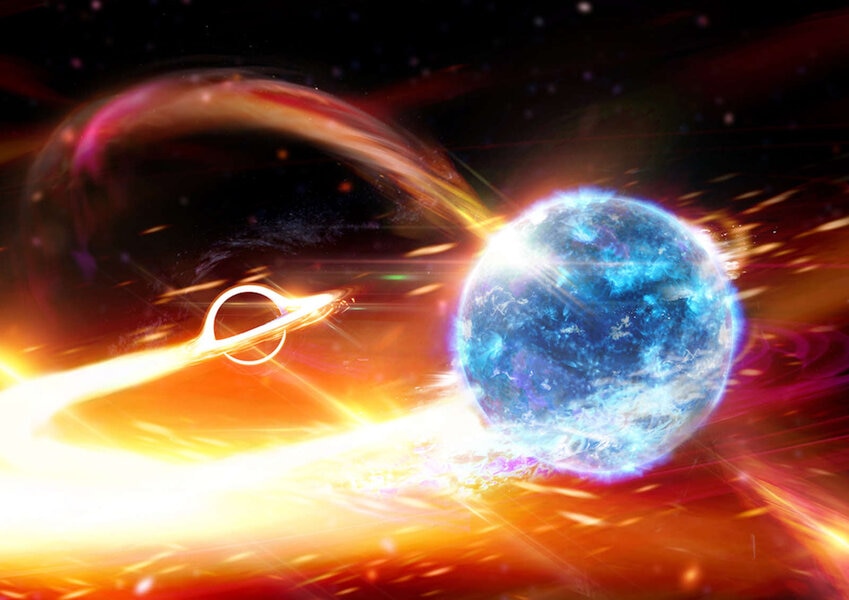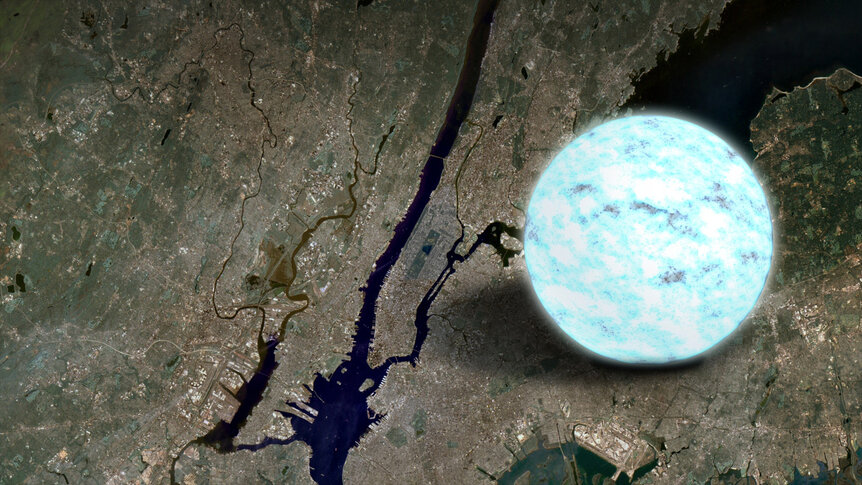Create a free profile to get unlimited access to exclusive videos, sweepstakes, and more!
Spacetime shakes: For the first time, astronomers see a black hole eating a neutron star

For the first time ever, astronomers have detected the scariest thing in the Universe eating the second scariest thing: A black hole devouring a neutron star.
This is simultaneously one of the coolest and most spine-chilling research results I've ever written about. A merger between these two densest types of objects in the Universe creates a colossal explosion, yet one that is utterly dark. The only way it was detected because it literally shook the fabric of spacetime.
Even better? Astronomers detected a second one just ten days later.
The fearsome events were found by the LIGO-Virgo collaboration, facilities designed to detect gravitational waves, actual ripples in the fabric of spacetime. Einstein predicted these waves would be generated by any mass being accelerated, but they are too low-amplitude and mushy to detect unless the object is massive, dense, and accelerated hard.
However, when black holes or neutron stars merge, objects that are mere kilometers across but mass as much as stars are accelerated around each other at soul-crushing rates, enough to create sharp gravitational waves. These waves expand outward at the speed of light, but weaken with distance. We can detect them from hundreds of millions or billions of light years away, but by then they have weakened so much the stretching of spacetime is extremely small, which is why they were predicted a century ago but weren't first detected directly until 2015 (I have details about that first momentous discovery and how this all works in an article from that time).
Dozens of events have been seen since then, mostly pairs of black holes merging, although neutron star mergers have been seen twice as well. Until now, though, no black holes have ever been seen to eat a neutron star — in fact, no black hole/neutron star binary system has ever been detected in our galaxy!
The events were detected on January 5, 2020 and January 15, 2020, and are called GW200105_162426 and GW200115_042309 respectively (GW for gravitational wave, and then the numbers are for the date and time of day they were detected). The first (let's call it GW200105) was a strong signal, but only seen clearly in one of three detectors (a second was shut off at the time, and it was only seen weakly in the third). The second (GW200115) was seen in all three*.
When a gravitational wave passes through the Earth, the shape and strength of the waves tell us a lot about the system that created them. Both events were statistically significant (meaning astronomers think they're real) and in both cases the masses of the two objects merging were quite low.
The two components that merged in GW200105 had masses of 8.9 and 1.9 times the mass of the Sun (with uncertainties of about 1.3 and 0.3 times the Sun's mass, respectively). The first component is well into black hole territory — the minimum mass for this type of black hole, we think, is about 2.8 times the Sun's. The second, though is below that limit, so is almost certainly a neutron star: The incredibly dense core of a massive star after the star has exploded as a supernova. A sphere of neutronium (as this matter is called) the size of a gumball would weigh as much as every single human being on Earth combined.
The same is true for the second event, GW 200115: The masses are 5.7 (±2 or so) and 1.5 (±.5 or so) times that of the Sun. So again, pretty clearly a black hole and neutron star.
Both systems started off life as two normal but massive stars orbiting each other. One was likely 20 or so times the Sun's mass. It ran through its nuclear fuel quickly, probably in only a few million years. It then swelled up into a red supergiant star (like Antares or Betelgeuse). It was so big it likely engulfed or nearly engulfed the companion star briefly, and that second star would have pulled a lot of mass off the first star, making itself more massive.
The first star then exploded, forming a black hole. Eventually the second star exploded as well, forming a neutron star (or, depending on the initial masses and how rapidly one lost material to the other, it could've been vice-versa). Either way what was left was a neutron star orbiting a black hole.
If a third star was in the system it could've kicked the two off-balance, making them orbit closer together. Or it's possible that over billions of years the two emitted weak gravitational waves as they orbited, losing energy and slowly spiraling together. Either way, eventually they got close enough together, and BANG. The black hole swallowed the neutron star.
Incidentally, if you're curious: What's left after this event is a more massive and larger black hole. That's part of a black hole's whole thing: Fall in, and you're now a part of the black hole.
The orbital energy of such a system right before That Final Moment is hard to fathom. Two objects totaling several times the mass of the Sun are whirling around each other at very nearly the speed of light. That energy has to go somewhere when the two merge. Where it goes is into shaking spacetime.
When this happens, some of the mass of the system is converted directly into the energy of gravitational waves. This is an immense amount of energy. In these two new cases something like half the mass of the Sun was converted into energy. Mind you, this is done via the equation E=mc^2, and the speed of light squared is a very, very big number. The final moments lasted mere seconds, but the amount of energy created was something like 100 quintillion times the Sun's total luminosity (1020) over the same amount of time!
Yet it was almost certainly completely dark. No light was emitted at all (no flash was seen by any telescopes, at least, and none was necessarily expected). All of the energy went into gravitational waves. Both events were roughly a billion light years away, and over that vast distance the signals weakened hugely. By the time they got here they were barely a whisper. Actually, to be honest, a whisper near the detectors would cause a far larger signal than these events did.
Mergers like these are important because we don't really understand completely how a black hole and neutron star system is formed, or how it evolves over time. Just seeing these events tells us these binary systems exist — a good start — and also how often they happen in our local volume of space (from these we'd expect there's roughly one merger every week somewhere within 2 billion light years of us). If more are detected, it will help astronomers figure out how these massive stellar binaries behave.
Which is great! As long as they're far away. That kind of event is fine by me when it happens in another galaxy. Even a closer one would be cool, to get a better signal and be able to analyze it better. But when one cosmic monster eats another, as amazing and cool as it is, I find I don't mind having a nosebleed seat.
*In 2019 a similar event was detected, where a massive black hole merged with what is likely a very low-mass black hole. It's possible the second object was an extremely massive neutron star, but pretty unlikely.




























